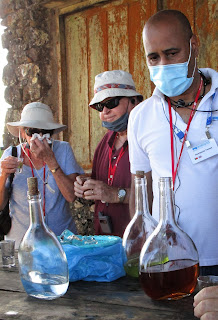Cape Verde means Green Cape. That is not how it looks today! The country is in the midst of a 4 year drought. I do not mean just too little rain. They have had NO rain.

The main income on the islands comes from fishing, farming and tourism. Fishing has kept the island alive the past months. Few ships stop at the island. Combine that with COVID, and tourism has been virtually nonexistent. The field of corn on the right was planted in anticipation of rain which did not come. In a few places crude windmills draw water, but with no rain, ground water is sparse. Even with irrigation, crops do not do well.
These islands are all volcanic, with one of the islands having an active volcano (December 2020.) The soil, where it can be cultivated is rich, but extremely rocky. There are not too many places where flat ground allows cultivation. Despite this, the island persists and is hopeful that tourism will soon return. Our ship was not scheduled to stop here, so we were and unexpected boost to the economy, even if we did not get out and shop.
 Our tour took us from sea level at Mindelo, the major cruise port, to the highest point on the island of St. Vincent, Salamanca. The Main road toward Baia Das Gatos is well paved, but when we turned north the road became a series of switchback. The surface was similar to cobblestone, but since all the rocks were volcanic, they had been laid so the there was a fairly flat surface, just quite rough.
Our tour took us from sea level at Mindelo, the major cruise port, to the highest point on the island of St. Vincent, Salamanca. The Main road toward Baia Das Gatos is well paved, but when we turned north the road became a series of switchback. The surface was similar to cobblestone, but since all the rocks were volcanic, they had been laid so the there was a fairly flat surface, just quite rough.

We could see our ship far below. At the top, we were above some of the clouds. When we got out, we had a choice of tea or coffee and a selection of local alcohol.
 The clear bottle held local rum --very powerful stuff!
The clear bottle held local rum --very powerful stuff!
I tried the other two, which were alcoholic, and a bit sweet.
From there we returned to sea level and had a stop so we could feel the warm water temperature.
 This statue at a small
This statue at a small
restaurant showed one method of catching fish. More often the men go out in small boats in the treacherous waters around the island.
There are not buildings constructed of wood, at least none we saw. Concrete blocks made up both the exterior frame and internal walls. Sand is plentiful and there is some local concrete. Many buildings are incomplete or abandoned, even in the cities. Many are painted in bright colors. You will see no steep roofs, since rainfall is so sparse.
Since this is a volcanic island, the beaches have coarse sand and the land is covered with many rocks. In most places vegetation is sparse. I did not see cactus, as I consider it, but there were some plants with long pointed "leaves" about 2 feet long. There is one exception to the course dark brown beaches Once in a while there will be an area of beautiful tan sand, almost dunes, with no vegetation. This is not "native" sand. It has blown in thousands of miles from the Sahara Dessert during massive sand storms. Our guide told us that you could see the clouds of sand approaching the island.















No comments:
Post a Comment